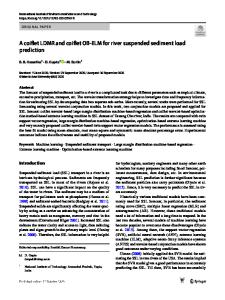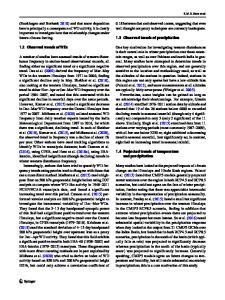Water discharge and suspended sediment dynamics in the Chandra River, Western Himalaya
- PDF / 5,187,091 Bytes
- 15 Pages / 595.276 x 790.866 pts Page_size
- 14 Downloads / 412 Views
Ó Indian Academy of Sciences (0123456789().,-volV)(0123456789( ).,-volV)
Water discharge and suspended sediment dynamics in the Chandra River, Western Himalaya AJIT T SINGH1,2,* , PARMANAND SHARMA1, CHIRAG SHARMA2, C M LALURAJ1, LAVKUSH PATEL1, BHANU PRATAP1, SUNIL OULKAR1,2 and MELOTH THAMBAN1 1
National Centre for Polar and Ocean Research (NCPOR), Ministry of Earth Sciences, Vasco-da-Gama, Goa 403 804, India. 2 School of Earth, Ocean and Atmospheric Sciences, Goa University, Goa 403 206, India. *Corresponding author. e-mail: [email protected] MS received 15 January 2020; revised 8 June 2020; accepted 8 June 2020
Glacier systems are important components of the hydrological cycle and a major source of meltwater and sediment Cux that controls the river ecology, water quality, and hydropower generation in the Indian Himalayan Region (IHR). Thus, understanding short- and long-term changes in water and suspended sediment (SS) dynamics is crucial in highly sensitive pro-glacial Himalayan Rivers. In the present study, the Chandra River basin in Western Himalaya was chosen to study river discharge, SS transport dynamics, physical erosion rate, and their governing factors for the 2017 melting season (May–September). The daily mean water discharge and SS concentration in the Chandra River was 260.7 m3s 1 and 775.5 mgL 1 with maximum discharge and SS Cux in the month of July. The air temperature showed significant relationship with the river discharge (R2 = 0.67; n = 156; p\0.001), which in turn controlled the SS export in the basin (R2 = 0.86; n = 130; p \ 0.001). An anticlockwise sediment-discharge hysteresis during peak Cow conditions suggest exhausted sediments or large distance of sediment transport ([100 km) from the upper glacierized region to the end of the basin. Statistical analysis of SS particle size showed poorly sorted immature grains with a dominance of silt particles (85%), followed by sand (8.5%) and clay (6.5%). The SS estimates revealed a total suspended sediment yield of 1285 tons km 2 yr 1 and physical erosion rate of 0.47 mm yr 1. Considering the socio-economic importance of the Himalayan region, the present study will help to evaluate the water and sediment budget of the Chandra River, Western Himalaya and to establish their relationship to the meteorological conditions in the basin. Keywords. River discharge; suspended sediment; hysteresis loop; grain size; Chandra River; Western Himalaya.
1. Introduction Himalayan glaciers are shrinking in the recent decades, generating an increased volume of meltwater and as a result, increased transportation of suspended sediment (SS) Cux (Immerzeel et al. 2012; Milner et al. 2017; Mao et al. 2019). The Indus, Ganga, and Brahmaputra river basins
together contribute *6–10% of global sediment inCux to the ocean, resulting in the buildup of world’s two largest submarine fans in the Arabian Sea and the Bay of Bengal (Subramanian 1993). Amount of SS Cux in a river directly aAects its water quality, which is necessary for sustaining river ecology, agriculture,
Data Loading...











